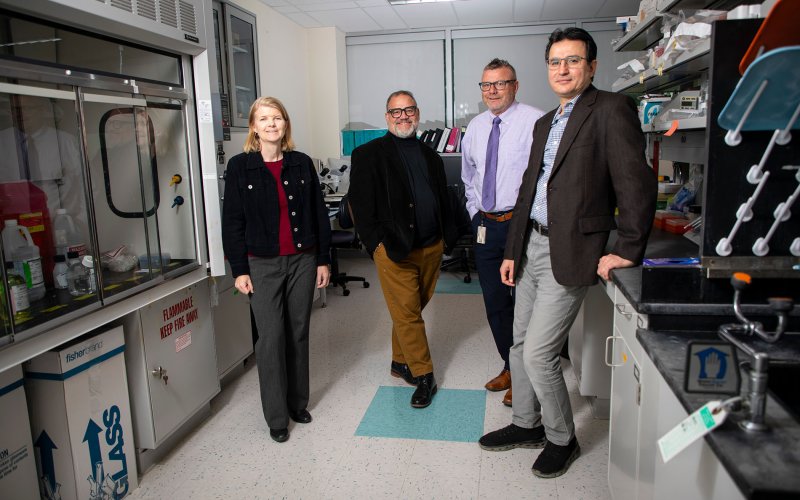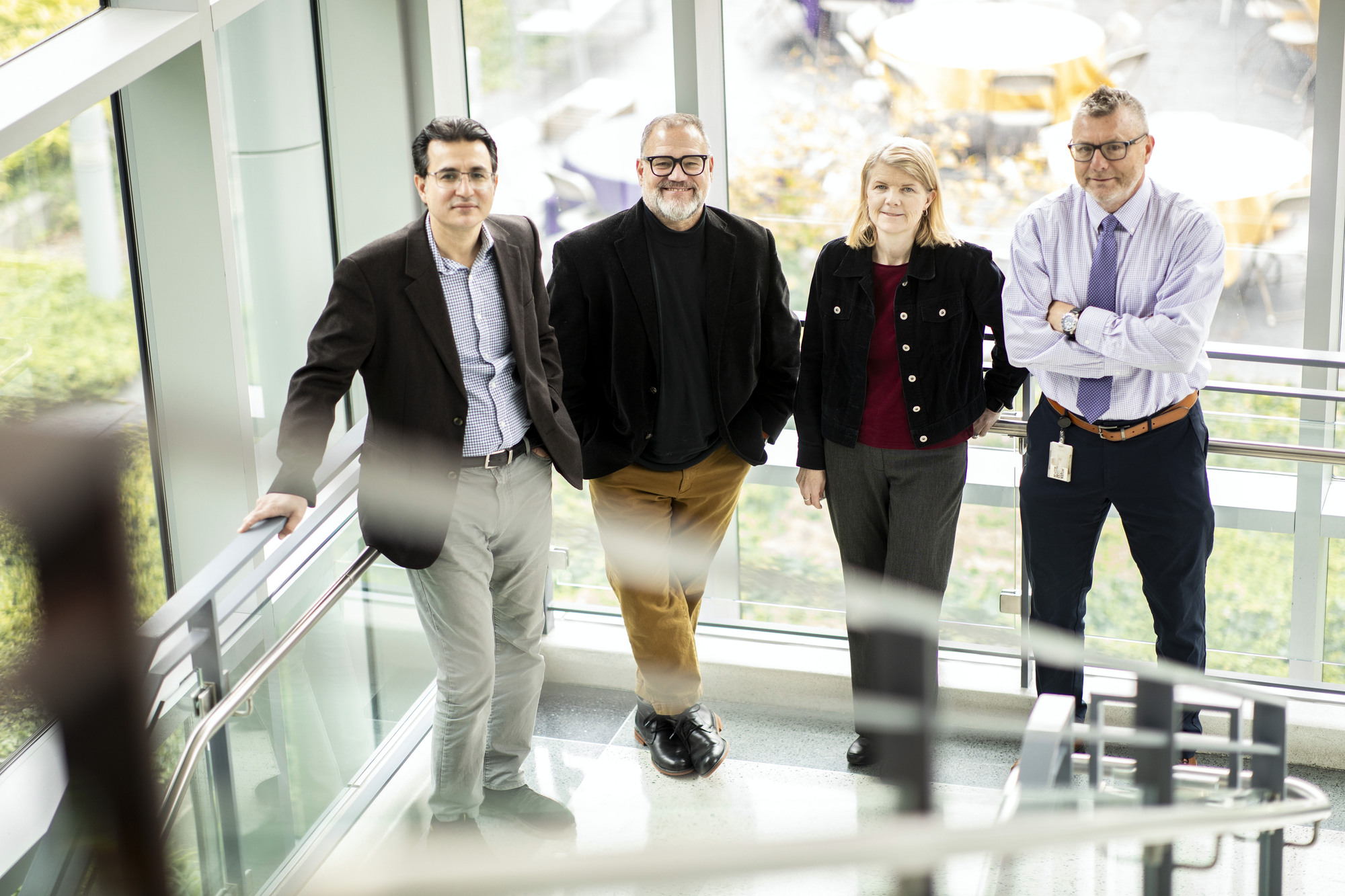Researchers Awarded Funding to Study Cell Senescence and Salivary Gland Dysfunction

By Erin Frick
ALBANY, N.Y. (Oct. 26, 2023) — An interdisciplinary research team at the University at Albany has received new funding to explore cellular mechanisms underlying salivary gland dysfunction and develop RNA-based therapeutics to stop processes associated with cell senescence that contribute to disease.
Reduced salivation can happen as a natural part of aging, as a side effect of radiation therapy for head and neck cancers, or as a symptom of certain autoimmune disorders. The resulting mouth dryness can cause general discomfort, impaired digestive function, trouble speaking, and dental hygiene issues such as cavities and chronic bad breath — all of which degrade quality of life for those affected.
“Previous work has shown that as the cells that comprise the salivary glands deteriorate with age — a process called senescence — they can cause inflammation and dysfunction in the gland that reduces saliva production,” said Melinda Larsen, a professor of biological sciences at UAlbany and co-principal investigator on the project. “In this work, we are hoping to identify key age-related factors that contribute to salivary gland dysfunction and develop RNA-based therapeutics that limit the severity of disease.”
The $387,186 one-year grant was awarded by the National Institute of Dental and Craniofacial Research, an arm of the National Institutes of Health. The project’s four principal investigators include scientists from the departments of biological sciences and chemistry in the College of Arts and Sciences and the department of nanoscale science and engineering in the College of Nanotechnology, Science, and Engineering; all PIs are affiliated with UAlbany’s RNA Institute.

“As the population grows older, so does demand for biomedical technologies and assistive resources that support healthy aging,” said Vice President for Research and Economic Development Thenkurussi 'Kesh' Kesavadas. “These innovations require creative thinking and cross-cutting collaboration. This project is the result of PIs from three departments and two colleges at UAlbany coming together to explore the ways that their skillsets can be combined to solve complex biomedical challenges — and represents exactly the sort of research synergy required to meet the needs of an aging population. We are proud to support this work.”
“These studies are among the first to explore RNA-based technologies for the treatment of oral disease and will be applicable toward the treatment of other age-related degenerative disorders,” said co-PI Andres Melendez, professor and chair of the Department of Nanoscale Science and Engineering at UAlbany. “This work represents a strong interdisciplinary effort that arose from our shared interests in expanding our collaborative relationships around RNA technologies and cell senescence.
“We are excited to advance this research as part of the university-wide healthy aging research initiative, working across colleges to improve the lives of those affected by salivary gland dysfunction, as well as other life-altering diseases.”
Sjögren’s syndrome as a model disease system
In this research, the team is focusing on salivary gland cells affected by Sjögren’s syndrome — a common autoimmune disease similar to lupus that affects an estimated 4 million people in the U.S. alone, the vast majority are women over 40.
“Sjögren’s syndrome harms exocrine glands, which are those responsible for producing substances like sweat, tears and saliva,” Larsen said. “When the cells that make up exocrine glands are damaged, these senescent cells accumulate in the gland and begin secreting substances (e.g., cytokines, growth factors, proteases) that disrupt the health of surrounding tissue and contribute to pathologies such as those associated with aging.”
Larsen’s research employs the use of organoids — in this case, tiny clusters of lab-grown human salivary gland tissue — which the team will use to explore the mechanisms within cells affected by Sjögren’s syndrome that disrupt healthy salivary gland functioning.
Structurally interacting RNA
At the core of the team’s efforts is an RNA technology developed by co-principal investigator Scott Tenenbaum, a professor in the Department of Nanoscale Science and Engineering at UAlbany, called “structurally interacting RNA” (sxRNA). With multiple biomedical applications such as vaccines, cell targeting and improved drug delivery, the technology directs RNA to connect with a tissue-specific cell in the body. This connection acts as a “switch” that can turn a desired mechanism within the cell either off or on.
The team is aiming to identify the mechanism in salivary gland cells that causes them to senesce and secrete harmful substances that cause gland dysfunction. With this target identified, sxRNA technology could be used to deliver therapeutics directly to senescent cells, turn off the “aging” mechanism and prevent damage to healthy tissue.
This technique has the potential to help alleviate symptoms and halt disease progression across multiple disease systems.
“When cells in the human body senesce, the tissue they form can change from soft and spongy to rigid and fibrous,” said Tenenbaum. “When this happens, the cells no longer work properly, and, like the harmful secretions observed in senescent salivary gland cells, this change can disrupt the functioning of healthy cells in the surrounding tissue. This progression is common in many aging-related diseases, including Alzheimer’s.
“We are trying to figure out what happens in senescent cells that causes them to create these sorts of problems. By understanding the genetics of senescent cells, we can identify targets for drugs designed to kill problematic cells while preserving healthy cells. It also gets us closer to eventually being able to create drugs that can stop or reverse processes of cell aging.”
Co-PI Mehmet Yigit, associate professor of chemistry at UAlbany, says that the success of this collaboration hinges on the complementary expertise of the PIs.
“Dr. Larsen has built a world-class research program in salivary gland development, regeneration and organoid engineering,” Yigit said. “Dr. Melendez has a long-established career in oxidative stress and cell senescence. Dr. Tenenbaum has over two decades of expertise in developing and commercializing RNA-based technologies. My expertise lies in RNA conjugation and nanoparticle-based delivery — essentially ‘packaging’ technologies like sxRNA to send to targeted cells. Working together, we are in a strong position to develop an sxRNA technology for the treatment of salivary gland disease.”
This collaboration was funded in part through a 2022 seed grant awarded by the University.




